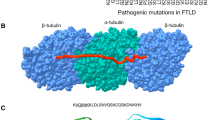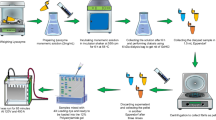Abstract
τ Isolated from paired helical filaments, aberrant structures that appear in Alzheimer disease (AD) patients’ brains, show at least two posttranslational modifications: phosphorylation (Grundke-Iqbal et al., 1986; Ihara et al., 1986) and glycation (Ledesma et al., 1994; Yan et al., 1994). To test whether these modifications could affect the capacity of τ to self-aggregate, recombinant τ was phosphorylated and glycated, and its capacity to form polymers analyzed. Our results indicate that on phosphorylation and glycation, the capacity of τ to form aggregates increases, and that glycation of τ could stabilize the assembled polymers and could facilitate formation of bundles from these polymers.
Similar content being viewed by others
References
Alonso A. C., Zaidi T., Grundke-Iqbal I., and Iqbal K. (1994) Role of abnormally phosphorylated tau in the breakdown of microtubules in Alzheimer disease.Proc. Natl. Acad. Sci. USA 91, 5562–5566.
Caceres A. and Kosik K. (1990) Inhibition of neurite polarity by tau antisense oligonucleotides in primary cerebellar neurons.Nature 343, 461–463.
Cleveland D., Hwo S. Y., and Kirschner M. W. (1977) Purification of tau, a microtubule associated protein that induces assembly of mircotubules from purified tubulin.J. Mol. Biol. 116, 207–225.
Crowther R. A., Olesen O. F., Jakes R., and Goedert M. (1992) The microtubule binding repeats of tau protein assemble into filaments like those found in Alzheimer’s disease.FEBS Lett. 309, 199–202.
Crowther R. A., Olesen O. F., Smith M., Jakes R., and Goedert M. (1994) Assembly of Alzheimer-like filaments from full length tau protein.FEBS Lett. 337, 135–138.
Drechsel D. N., Hyman A. A., Cobb M. H., and Kirschner M. W. (1992) Modulation of the dynamic instability of tubulin assembly by the microtubule-associated protein tau.Mol. Biol. Cell. 3, 1141–1154.
Drewes G., Lichtenberg-Kraag B., Doring F., Mandelkow E. M., Biernat J., Goris J., Doree M., and Mandelkow R. (1992) Mitogen activated protein (MAP) kinase transforms tau protein into an Alzheimer-like state.EMBO J. 11, 2131–2138.
Drubin D. G. and Kirschner M. W. (1986) Tau protein function in living cells.J. Cell Biol. 103, 2739–2746.
Eble A. S., Thorpe S. R., Baynes J. W. (1983) Nonenzymatic glucosylation and glucose-dependent crosslinking of protein.J. Biol. Chem. 258, 9406–9412.
García de Ancos J., Correas I., and Avila J. (1993) Differences in microtubule binding and self association abilities of bovine brain tau isoforms.J. Biol. Chem. 268, 7976–7982.
Goedert M., Spillantini M., Jakes R., Rutherford D., and Crowther R. A. (1989) Multiple isoforms of human microtubule associated tau: sequences and localization in neurofibrillary tangles of Alzheimer’s disease.Neuron 3, 519–526.
Greenberg S. D. and Davies P. (1990) A preparation of paired helical filaments that displays distinct tau proteins by polyacrylamide gel electrophoresis.Proc. Natl. Acad. Sci. USA 87, 5827–5831.
Grundke-Iqbal I., Iqbal K., Tung Y. C., Quinlan M., Wisniewski H. M., and Binder L. I. (1986) Abnormal phosphorylation of the microtubule associated protein tau in Alzheimer cytoskeletal pathology.Proc. Natl. Acad. Sci. USA 83, 4913–4917.
Ihara Y., Nukina N., Miura R., and Ogawara M. (1986) Phospyorylated tau is integrated into paired helical filaments in Alzheimer’s disease.J. Biochem. 99, 1087–1810.
Iqbal K., Zaidi T., Bancher C., and Grundke-Iqbal I. (1994) Alzheimer paired helical filaments. Restoration of the biological activity by dephosphorylation.FEBS Lett. 349, 104–108.
Ishiguro K., Omori A., Takamatsu M., Sato K., Arioka M., Uchida T., and Imahovi K. (1992) Phosphorylation sites on tau by tau protein kinase I, A bovine derived kinase generating an epitope of paired helical filaments.Neuroscience 128, 195–198.
Kosik K. (1992) Alzheimer’s disease a cell biology perspective.Science 256, 780–783.
Kosik K. S., Joachim C. L., and Selkoe D. J. (1986) Microtubule associated protein tau is a major antigen component of paired helical filaments in Alzheimer’s disease.Proc. Natl. Acad. Sci. USA 83, 4044–4048.
Ledesma M. D., Correas I., Avila J., and Díaz-Nido J. (1992) Implication of brain cdc2 and MAP2 kinases in the phosphorylation of tau protein in Alzheimer’s disease.FEBS Lett. 308, 218–224.
Ledesma M. D., Bonay P., Colaco C., and Avila J. (1994) Analysis of microtubule associated protein tau glycation in paired helical filaments.J. Biol. Chem. 269, 21,614–21,619.
Matsuo E. S., Shin R. W., Billingsley M. L., VandeVoorde A., O’Connor M., Trojanowski J. Q., and Lee V. M. Y. (1994) Biopsy-derived adult human brain tau is phosphorylated at many of the same sites as Alzheimer’s disease paired helical filaments tau.Neuron 13, 989–1002.
Medina M., Montejo de Garcini E., and Avila J. (1995) The role of tau phosphorylation in transfected COS-1 cells.Mol. Cell. Biochem. 148, 79–88.
Montejo de Garcini E., Serrano L., and Avila J. (1986) Self assembly of microtubule associated protein tau into filaments resembling those found in Alzheimer disease.Biochem. Biophys. Res. Commun. 141, 790–796.
Montejo de Garcini E., Carrascosa J. L., Correas I., Nieto A., and Avila J. (1988) Tau factor polymers are similar to paired helical filaments of Alzheimer’s disease.FEBS Lett. 236, 150–154.
Mori M., Kondo J., and Ihara Y. (1987) Ubiquitin is a component of paired helical filaments in Alzheimer’s disease.Science 235, 1641–1644.
Morishima-Kawashima M., Masegana M., Takio K., Suzuki M., Titani K., and Ihara Y. (1993) Ubiquitin is conjugated with amino-terminally processed tau in paired helical filaments.Neuron 10, 1151–1160.
Nieto A., Correas I., López-Otin C., and Avila J. (1991) Tau related protein present in paired helical filaments has a decreased tubulin binding capacity as compared with microtubule associated protein tau.Biochem. Biophys. Acta 1096, 197–204.
Padilla R., López Otin C., Serrano L., and Avila J. (1993) Role of the carboxy terminal region of β tubulin on microtubule dynamics through its interaction with the GTP phosphate binding region.FEBS Lett. 235, 173–176.
Troncoso J., Costello A., Watson A., and Johnson G. (1993) In vitro polymerization of oxidized tau into filaments.Brain Res. 613, 313–316.
Wille H., Drewes G., Biernat J., Mandelkow E. M., and Mandelkow E. (1992) Alzheimer-like paired helical filaments and antiparallel dimers formed from microtubule associated protein tau in vitro.J. Cell. Biol. 118, 573–584.
Wischik C. M., Novak M., Edwards P. C., Klug A., Tichelaar W., and Crowther R. A. (1988) Structural characterization of the core of the paired helical filament of Alzheimer disease.Proc. Natl. Acad. Sci. USA 85, 4506–4510.
Wood J. G., Mirra S., Pollock N. J., and Binder L. I. (1986) Neurofibrillary tangles of Alzheimer’s disease share antigenic determinants with the axonal microtubule-associated protein tau.Proc. Natl. Acad. Sci. USA 83, 4040–4043.
Yan S. D., Chen X., Schmidt A. M., Brett J., Godman G., Zou Y. S., Scott C. W., Caputo C., Frappier T., Smith M. A., Perry G., Yen S., and Stern D. (1994) Glycated tau protein in Alzheimer disease: A mechanism for induction of oxidant stress.Proc. Natl. Acad. Sci. USA 91, 7787–7791.
Author information
Authors and Affiliations
Rights and permissions
About this article
Cite this article
Ledesma, M.D., Medina, M. & Avila, J. The in vitro formation of recombinant τ polymers. Molecular and Chemical Neuropathology 27, 249–258 (1996). https://doi.org/10.1007/BF02815107
Received:
Accepted:
Issue Date:
DOI: https://doi.org/10.1007/BF02815107




